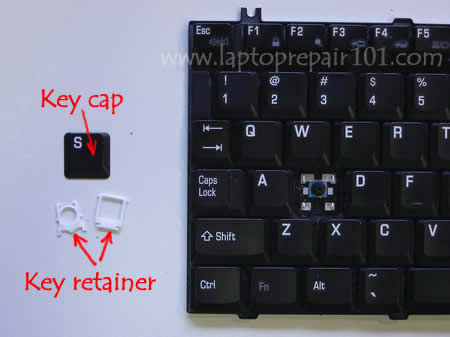Has a key on your Dell laptop suddenly popped off, leaving you with a frustrating keyboard gap? Don’t fret; you don’t have to replace the entire keyboard just yet. With the right tools and a little know-how, you can restore your keyboard to its former glory in no time. This guide will provide you with a step-by-step walkthrough of how to put keys back on your Dell laptop, empowering you with the knowledge to tackle this minor repair yourself.

Image: h30434.www3.hp.com
Understanding Laptop Key Mechanisms
Before we dive into the repair process, let’s briefly explore how laptop keys are attached. Most Dell laptops utilize a scissor-switch mechanism, which consists of two interlocking plastic parts: the keycap (the visible part) and the scissor mechanism (the underlying frame). Pressing a key causes the scissor mechanism to pivot, registering a keystroke. If a keycap accidentally detaches, you simply need to align and snap it back into place.
Materials You’ll Need
To put keys back on a Dell laptop, you’ll need the following:
- Replacement keycap if available (for lost or damaged keys)
- Flat-head screwdriver or plastic spudger
- Toothpick or tweezers (optional)
Step-by-Step Guide
1. Power Down and Disconnect:
Before you start any repair, it’s crucial to power down your laptop and unplug it from external power sources. This ensures your safety and prevents any accidental damage.
2. Locate and Examine the Detached Key:
Carefully inspect the loose key to determine if it’s repairable or needs replacement. If it’s chipped or cracked, it’s advisable to get a new keycap.
3. Identify the Key’s Position:
Examine the keyboard and find the vacant spot where the key belongs. Note the surrounding keys to help you identify its accurate position.
4. Remove the Broken Key’s Scissor Mechanism (Optional):
While some keys can be reattached to their original scissor mechanism, others may require the scissor mechanism to be replaced. If the mechanism is also detached or damaged, use a flat-head screwdriver or plastic spudger to gently pry it up and separate it from the keycap.
5. Align and Insert the Keycap:
With the scissor mechanism in place, carefully align the keycap with the mounting points on the scissor mechanism. One edge of the keycap typically has small hooks that fit into slots on the mechanism. Gently push down on the center of the keycap until it clicks into place.
6. Adjust the Key Position:
After attaching the keycap, check if it’s correctly positioned. Use a toothpick or tweezers to gently adjust its alignment until it fits snugly with the surrounding keys.
7. Test the Key:
Once the key is back in place, power on your laptop and test the key to ensure it’s functioning correctly. Repeatedly press the key a few times to make sure it’s stable and responsive.

Image: williamsdires1998.blogspot.com
How To Put Keys Back On Dell Laptop
Additional Tips
- If the keycap is loose but doesn’t come off completely, you may be able to snap it back into place by applying gentle pressure.
- When reattaching keys to scissor mechanisms, be careful not to bend or break the fragile plastic parts.
- If you’re replacing a lost or damaged keycap, make sure to order the correct keycap compatible with your laptop model and keyboard layout.
- For complex repairs or if you’re uncomfortable performing the repair yourself, contact Dell Support or seek assistance from a reputable repair technician.
By following these steps carefully, you can successfully put keys back on your Dell laptop and restore your keyboard to its original functionality. If you encounter any difficulties during the repair, refer back to the steps or consult reliable online resources for additional guidance.


/GettyImages-1303637-two-way-mirror-57126b585f9b588cc2ed8a7b-5b8ef296c9e77c0050809a9a.jpg?w=740&resize=740,414&ssl=1)


